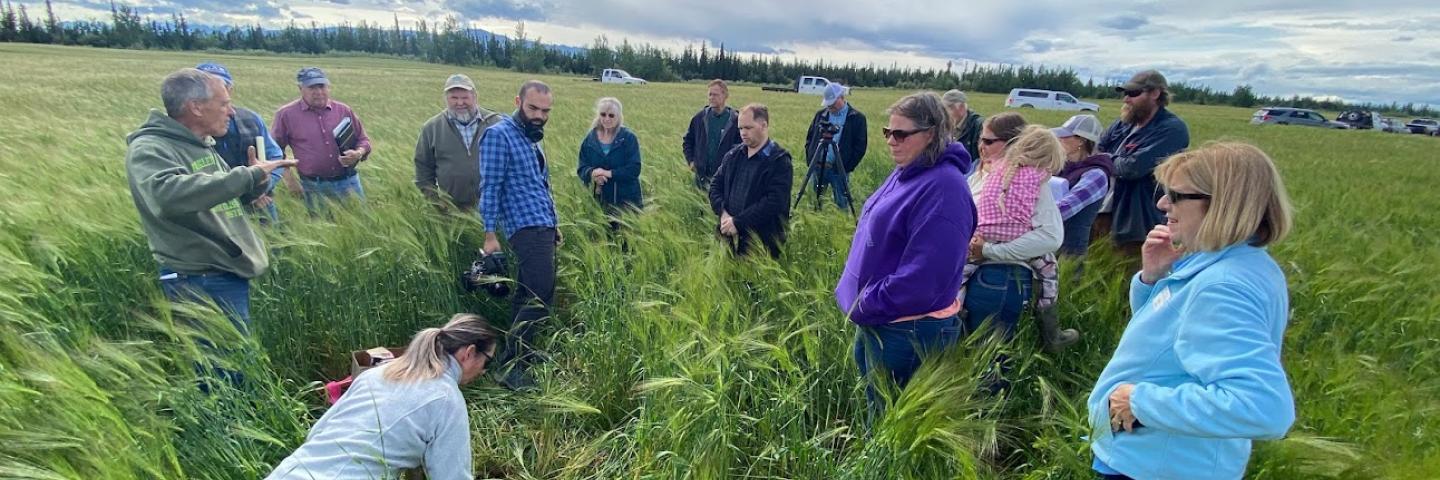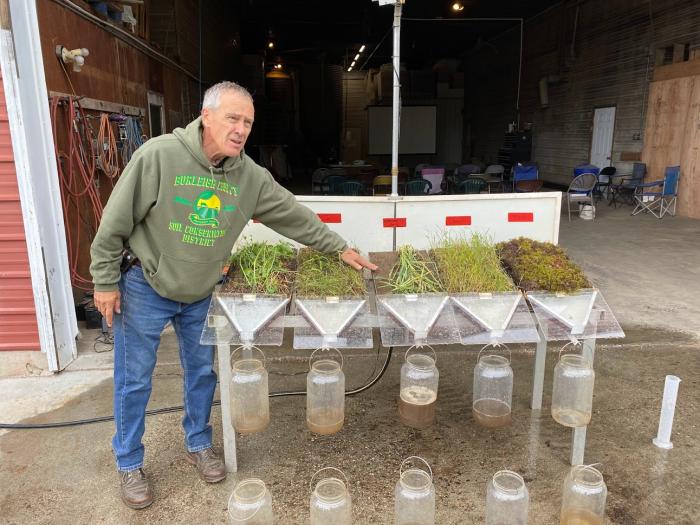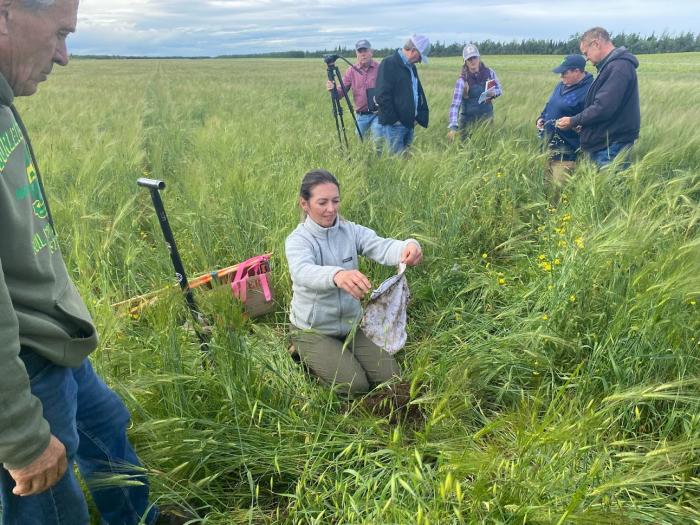Delta Junction Farmers Explore Soil Health

Local farmers and natural resource professionals gathered at the Alaska Flour Company to learn about regenerative agricultural practices that build healthier, more resilient soils during the Third Annual Soil Health Field Day, hosted by the Salcha-Delta Soil and Water Conservation District (SWCD).
View Storymap Version of this Article

DELTA JUNCTION, ALASKA – July 21, 2022 – Local farmers and natural resource professionals gathered at the Alaska Flour Company to learn about regenerative agricultural practices that build healthier, more resilient soils during the Third Annual Soil Health Field Day, hosted by the Salcha-Delta Soil and Water Conservation District (SWCD).
Bryce Wrigley, owner and operator of Wrigley Farm and the Alaska Flour Company, hosted the event on his farm and shared his personal experience with using no-till and cover crops on his barley operation. Wrigley is also the district manager of the Salcha-Delta Soil and Water Conservation and has served in that role since 2004.
This year’s event featured guest speaker Jay Fuhrer, a world-renowned expert in soil health management practices from Bismarck, North Dakota. Fuhrer is a retired soil health specialist from the USDA Natural Resources Conservation Service (NRCS) with 40 years of experience working with cropping systems, grazing systems, cover crops and gardens. He works on the Menoken Farm , a 150-acre demonstration farm east of Bismarck owned and operated by the Burleigh County Soil Conservation District.
Fuhrer, along with Meghan Lene, agricultural specialist with the Salcha-Delta SWCD, performed several demonstrations including a slake test, rainfall simulator, and in-field infiltration assessments to illustrate the benefits of soil health management practices. His presentations focused on the 5 Principles of Soil Health:
- Keep it Covered
- Minimize Disturbance
- Maximize Diversity
- Keep a continual living root
- Integrate Livestock
“When we bring these soil health principles together and use them as one integrated system, we see benefits to water quality and quantity, reduced wind and water erosion, improved water holding capacity and moves us toward the ultimate goal of more nutrient dense foods, among other benefits,” he said.
Multiple soil health principles are actively used at Wrigley Farm, with ‘minimize disturbance’ being the most prominent as 100% of the barley fields are in a no-till system. The farm also has about 150 acres in cover crops with a diverse seed mix and use of continuous living roots.
It’s all about the Carbon
“Tilling the soil is done for maximum release of nutrients; it’s like fracking an oil field for maximum release of oil,” Fuhrer said. “It really all comes down to carbon. A no till system provides minimum carbon loss, and a cover crop provides maximum carbon input.”
He explained that the higher the carbon to nitrogen ratio, the slower the release of nutrients and the slower the rate of decomposition. Soil has a baseline carbon/nitrogen ratio of 10 to 1, so farmers can strategically use no-till and cover crops to adjust the ratio and achieve a desired rate of decomposition.
Benefits of Decomposition
But what’s so significant about decomposition? Well, one way to find out is to take the Tighty Whitie Soil Test.
Lene conducted the test which illustrates various levels of soil decomposition in conjunction with soil health management practices. She buried cotton underwear in the top 10 to 12 inches of soil and then dug them up six weeks later.
The resulting levels of decomposition are indicators of active soil microbiology. There was noticeably more decomposition in the underwear planted in no-till, cover crop systems versus conventional tilled plots.
Increased microbial activity means more workers in the soil (soil microbes) which means healthier soil and healthier crops.
“We are starting to see more data now about when we improve the health of the soil microbiology, we can have a direct benefit on the nutrient density in our food,” Fuhrer said.

Active and Passive Armor
No-till is often used in conjunction with cover crops and/or leaving crop residue on the fields after harvest. A cover crop is a crop planted for the sole purpose of protecting and feeding the soil, not as a harvestable cash crop. Cover crops are typically planted after harvest and left to overwinter; then they are terminated the next year before spring planting.
However, Alaska's short growing season doesn't allow for cover crops to establish well after harvest time, so replacing fallow with cover crops is an ideal solution.
“A live cover crop is active armor, like a protective blanket,” Fuhrer said. “Leaving the crop stubble on the soil surface is passive armor which also provides a benefit.”
Capturing Every Drop
Fuhrer emphasized that keeping the soil covered reduces erosion, builds more organic matter which in turn fosters active soil microbial activity, and retains more soil moisture.
“We have to capture every raindrop
when it falls,” he said. “Soil that is covered will retain more moisture; though some of that will be naturally lost to transpiration. However, keep in mind that transpiration buys you something, whereas evaporation always costs you something.”
Integrating the Principles into One System
The resounding takeaway of the day is that there is no one-size-fits-all solution to building healthier soils, but answers can be discovered by integrating multiple soil health principles into one system. That and a healthy amount of curiosity and a willingness to try new approaches, learn from them, and adjust the sails for next season.
“I don’t want to treat a symptom. I want to address the problem. In agriculture we get caught up sometimes in just treating a symptom that we don’t always see the problem,” Fuhrer said.
“Farming is an extraction business and most likely always will be, but it’s also a balancing act. As farmers we must ask ourselves how can we regenerate that system and allow it to be sustainable? Using practices like cover crops, no-till and integrating livestock can go a long way to cycle those nutrients back into the soil.”

